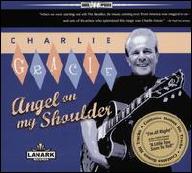Born May 14, 1936 (the same day as Bobby Darin), with his surname originally spelled "Graci", Charlie Gracie grew up in South Philadelphia, listening to country music and big-band jazz. At age ten, he obtained his first guitar, and by 15 he was a prodigy, performing regularly and winning contests on the simulcast radio and television show of early jazz great Paul Whiteman. Signed first to Cadillac Records, Gracie's first single, "Boogie-Woogie Blues," recorded in 1951, was not a hit, nor were a couple of follow-ups for other labels. In 1956, he was signed to the fledgling Cameo label. Gracie's first recording for the label consisted of two songs written by the label's co-owners, Bernie Lowe and Kal Mann, "Butterfly" and "Ninety-Nine Ways." With repeated appearances on American Bandstand, as well as The Ed Sullivan Show and other TV programs of the day, Gracie's popularity soared, and by April 1957, "Butterfly" had reached number one in the States. ("Butterfly" also became a chart-topper for crooner Andy Williams the same year.) Gracie's style was not as raucous as fellow early rockers such as Gene Vincent or Eddie Cochran, but he made up for any loss of grit with an undeniable professionalism and easy likability. likability guitar style has been described as a mix of rockabilly, jump blues, swing, and country boogie, while his vocals incorporate pop, blues, R&B, and rock & roll influences.
Another Mann-Lowe composition, "Fabulous," followed "Butterfly" in the spring of 1957, reaching number 16 in the U.S. and number eight in the U.K. Gracie subsequently toured the U.K. -- only the second American rock & roll act to tour there, following Bill Haley the Comets -- headlining at the Hippodrome Theater. He scored only one further hit in America, "I Love You So Much It Hurts," written by country singer Floyd Tillman, which only reached number 71 (although it reached number 14 in the U.K.). His biggest hit in England was yet to come, "Wanderin' Eyes," which reached number six there, and he logged his final U.K. hit with 1957's "Cool Baby." Gracie continued to record for Cameo into 1958, when he had a falling out with Lowe; Gracie would later file suit against Cameo for unpaid royalties. Dick Clark, who had a business relationship with Cameo, didn't book him on American Bandstand after that, and Gracie faded from the charts.
He recorded for several other labels into the '60s, including Coral and Roulette, and he continued to perform regularly both near Philadelphia, in the U.K., and in Europe, where the rockabilly revival kept his popularity high for decades. In 2001, Gracie struck up a friendship with Quentin Jones, a guitarist and rockabilly enthusiast who ran the independent Lanark Record label. Jones and Gracie began working together, with Jones anchoring the band when Gracie played a string of dates opening for Van Morrison, as well as producing his 2001 studio effort I'm All Right. In 2006, after many years out of print, Gracie's Cameo Records material was finally released on the CD compilation The Best of Charlie Gracie 1956-1958, and the following year, a documentary film chronicling his life story, Fabulous, was aired on PBS stations. In 2011, Gracie and Jones teamed with legendary producer and sideman Al Kooper to cut a new album. For the Love of Charlie included guest appearances from longtime fans Graham Nash, Peter Noone (of Herman's Hermits), Jimmy Vivino (from Conan O'Brien's band), and Dennis Diken (of the Smithereens). ~ Mark Deming & Jeff Tamarkin, Rovi
|
1
|
|
Butterfly |
|
2
|
|
Fabulous |
|
3
|
|
Wanderin' Eyes |


















